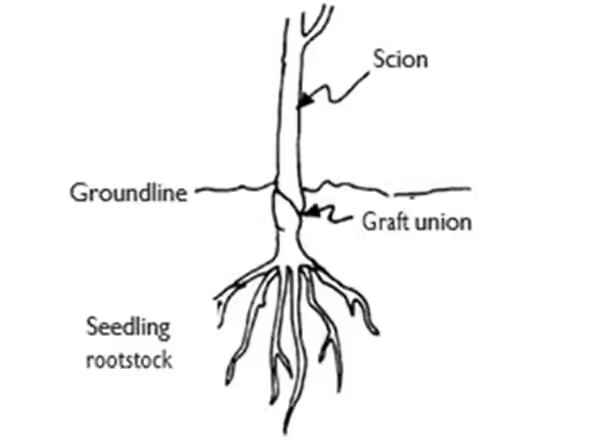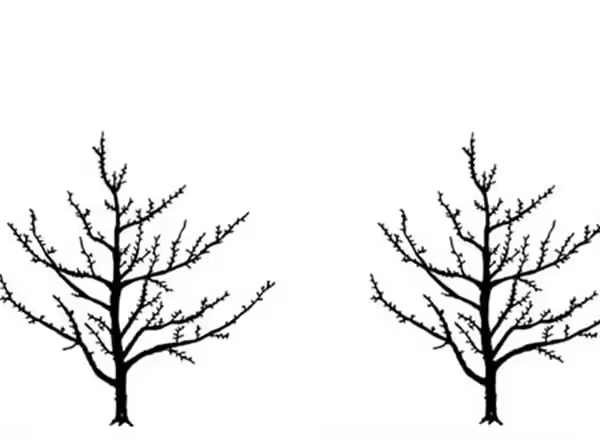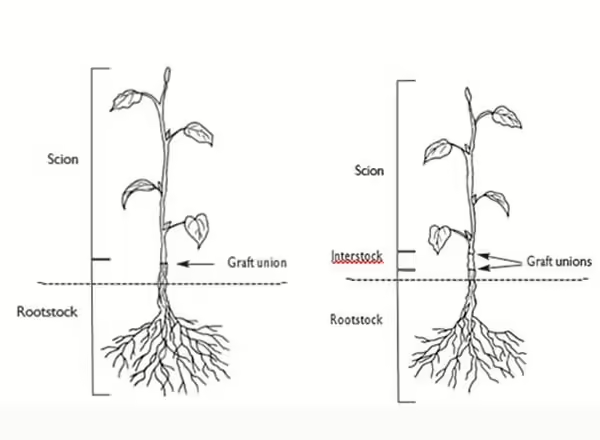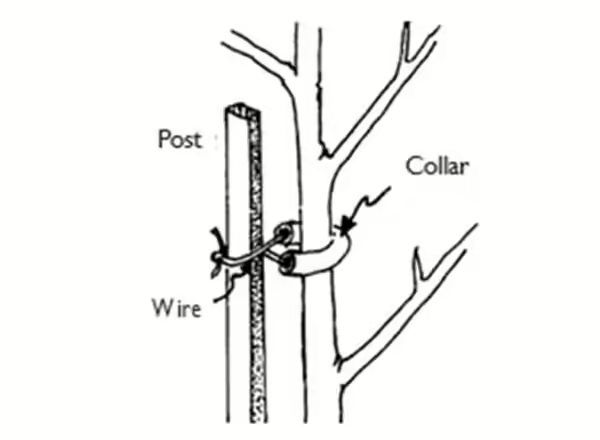
Selection of Fruits
Fruit trees are produced by budding or grafting a bud or shoot (scion) of a desired cultivar onto a root or rootstock. Various kinds of rootstocks are now being used. Some have a dwarfing effect on the scion.

Seedling rootstocks are obtained by planting seed such as ‘Elberta’ peach seed or ‘Red Delicious’ apple seed. The young plant growing from the seed is called a seedling. If it is used as a rootstock, it is called a seedling rootstock. To make a ‘Red Delicious’ tree on a seedling rootstock, the nurseryman grafts a scion (small branch) of a ‘Red Delicious’ tree onto an apple seedling root.
Varieties grafted onto seedling rootstocks are listed as standard trees. If no rootstock is listed and the tree is not called a dwarf or semi-dwarf, one can assume the trees are on seedling rootstocks.
Seedling rootstocks have little or no dwarfing effect on the scion. Standard trees are large, productive, and long-lived.

Fruit tree size can be reduced by genetic selection, by use of dwarfing rootstocks or dwarfing inter- stocks, and by cultural practices.
Genetic Selections
Some plants, such as ‘North Star’ and ‘Meteor’ cherries, are naturally dwarfs. In apples, bud mutations, called sports, have been selected for spur-type trees of ‘Red Delicious,’ ‘Golden Delicious,’ and other varieties. These spur types form fewer lateral (side) branches and more spurs (shortened, fruit bearing branches) than regular trees (Figures N 2A. and N 2B). In general, spur-types grow more slowly than regular types, may come into bearing earlier, and usually make a smaller tree. They may be grafted or budded on dwarfing stocks. Such a combination is sometimes called a double dwarf. In nursery catalogs, spur types have the word “spur” included in the variety name or the variety is listed as a spur type.

Dwarfing Rootstocks
Dwarfing rootstocks are natural dwarfs or semi-dwarfs that reduce the growth of scion varieties grafted onto them.
Dwarfing Interstocks
Dwarfing interstocks are grafted onto seedlings or other rootstocks. The scion variety is then grafted onto the interstock. These are called double-worked trees.
Cultural Practices to Encourage Dwarfing
Early, heavy, and regular bearing is an essential part of keeping trees small. Apply enough nitrogen fertilizer to keep trees healthy but not enough to make them grow excessively. Prune dwarf trees regularly and moderately. Summer tip pruning discourages growth and is a valuable aid in keeping trees small. Spraying fruit trees with plant growth regulators such as Apogee® leads to reduction in terminal shoot growth.
Dwarfing Rootstocks for Specific Fruits
Though dwarfing rootstocks are sometimes used for these fruits, the tree combinations usually are weak and short-lived. Standard trees are suggested. Peach trees on St. Julian dwarfing rootstocks are reasonably satisfactory. ‘Compact Redhaven’ is a natural dwarf tree. If dwarf sour cherry trees are desired, use the natural dwarfs ‘Meteor,’ ‘North Star,’ or ‘Suda Hardy.’ ‘Spur type Montmorency’ is semi-dwarf.
Pears
Quince is a satisfactory dwarfing rootstock for pears.
Apples
Many dwarfing stocks are used for apples. They vary in the degree of dwarfness imparted to the scion. The natural vigor of the scion also affects tree size. ‘Red Delicious,’ a vigorous scion, will make a larger tree on a specific rootstock than will the moderately vigorous scions, ‘Golden Delicious’ and ‘Jonathan.’ ‘Red Delicious’ is difficult to keep small even on the most dwarfing rootstocks.
Currently the most popular dwarfing stocks belong to the Malling (M) and Malling Merton (MM) groups. With proper care they can be kept within the following height ranges.
Rootstock: Height Range
- Bud 9: 8 to 12 feet
- M9: 8 to 12 feet
- Geneva 30: 10 to 14 feet
- M7, M26, Insterstems: 10 to 14 feet
- MM 106, MM III: 14 to 18 feet
- Spur types on seedling roots: 10 to 14 feet
- Spur types on M7, MM III: 8 to 12 feet

M 9 has weak roots and needs support. M 26 may be able to stand without support. Guy wires may be used to brace the trunk but are a nuisance when mowing. A single post placed on the southwest side of the tree usually is adequate. Use a 3 inch or 4 inch x 7 foot post. Dig the posthole about 1 foot from the trunk and make it 3 feet deep. Attach the tree to the post with wire. Use a short piece of garden hose to protect the trunk from the wire.